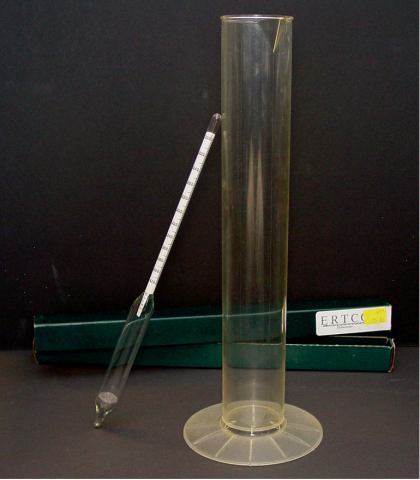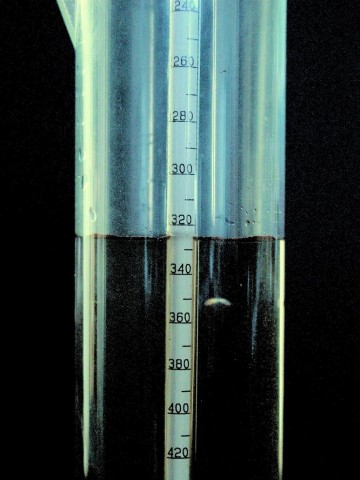
Hydrometers are widely used to measure specific gravity, or density, of liquid materials. Most people have used a form of hydrometer to check the level of glycol antifreeze in their car radiator or the battery acid strength in the car battery. Those types typically employ a series of colored balls that individually will float up at various densities to indicate strength. ERTCO manufactures the glass hydrometers that we use for testing of our BioBrineTM product line of magnesium chloride, calcium chloride, and sodium chloride liquids for deicing. If you are making salt brines, now ERTCO offers a specific hydrometer for salt brines that shows the percentage of salt, but we use the standard chemical laboratory glass hydrometers with graduation marks in 0.000 increments for accuracy and these are the hydrometers that we suggest be used as they are reliably accurate.
While not a chemical test that gives a percentage of ingredients per se, hydrometers are the backbone of spot checking the density of a liquid deicer to confirm that it is either within specification or not. Heavy chemicals are materials that are heavier than water. Water has a specific gravity of 1.000 at 68F (room temperature). We know from high school science that water weighs 8.34 (8.3369) pounds per US gallon. This basic understanding is important, because any liquid deicer that is heavier than water will be the specific gravity times the weight per gallon of water to determine the weight per gallon of the liquid deicer. 32% liquid calcium chloride weighs 11.03 lbs per gallon and that is determined by multiplying the specific gravity, 1.322, times the weight per gallon of water, 8.34 to arrive at 11.03. This fundamental basis is the used for all the common liquid deicers that we encounter in snow and ice management.
For example, if you were to receive a bulk tank truck delivery of 32% liquid calcium chloride deicer, you could capture a sample and then fill up a one gallon jug with the product and it should weigh pretty close to 11 lbs. If it is 9 or 10 lbs, then you are getting a good bit more water in the load then you expected, and if its 12 lbs, then you are getting additional solids in the material that could be calcium or could be something else, but in any case it is clear that it is not within the specification range for 32% calcium chloride which you ordered. It is almost too easy to for the dishonest butcher to put his thumb on the scale when weighing up the deli order, and accordingly it is also easy for the dishonest liquid deicer supplier to put a little more water in the product and not have the customer catch that he just got 27% CaCl2 even though the paperwork says it is 32%. The use of the hydrometer will empower you to quickly see if what you bought is within specification or not.
Here is a common chart showing the specific gravity of various concentrations of calcium chloride liquid. In the second column from the left, you will find a list of specific gravities which correspond to the percentage of calcium chloride in the solution indicated immediately to the left. The other columns of this chart show the gallons per ton of the solution (and dry) along with equivalent levels of flake, pellet, anhydrous calcium with the final column being the approximate freezing point.
Using the information on the chart above, we’ve outlined in red the 32% calcium chloride row and corresponding specific gravity of 1.322
To properly use the hydrometer there are some basic things that one must understand to get accurate readings consistently and over time. First, the torpedo style of lead filled glass hydrometer that we advocate, floats up higher and higher as density of the material increases. Understanding that water is specific gravity of 1.00, we want the hydrometer to settle in this solution at 1.322 to tell us that is on specification.
The materials needed to perform the simple test:
You will need a clear graduated cylinder, a hydrometer that covers the range of material densities you need to check, and, a sample of the material to be checked that is sufficient in size to fill the graduated cylinder at least ¾s full. The hydrometer MUST ALWAYS be kept clean and dry; any accumulation of dried solids on the walls of the glass hydrometer will change the weight of the hydrometer and cause it to sink farther into the liquid and give a false reading.

Start by confirming that the hydrometer is the within the estimated range of the material that you are testing. For this exercise, we are going assume that we just received a tank truck delivery of 32% liquid calcium chloride. Referring to the chart, we scroll down to 32% CaCl2 and then across to the specific gravity column showing 1.322 @ 77F. We next select the properly ranged hydrometer, which in this case is the ERTCO #2541, with a range from 1.200-1.420.
Make sure that the sample is at room temperature; cold contracts (more dense) and hot expands (less dense) so temperature is an important factor to consider when checking specific gravities. Fill up the graduated cylinder 2/3rds full with the sample being careful to pour slowly to avoid any bubbles. If the sample has bubbles in it, you have to wait for them to rise and the sample to be free of bubbles with will float the hydrometer and give a false reading. Make sure the hydrometer is clean and dry! Next take the hydrometer and carefully and SLOWLY slip it into the center of the graduated cylinder being careful to not just drop it like a depth charge and not scraping the walls of the cylinder as it submerges into the sample. Read the line at the surface and not at the meniscus which is the curved surface gripping the walls of the cylinder.
Since you know that it should be around 1.322 gravity, continue to carefully allow the hydrometer to sink until you get close to the target point (1.320 on the markers in the glass tube) and then allow the hydrometer to settle gently without over-sinking and bobbing back up. If the hydrometer sinks deeper (depth charge drop) and then rises it will have liquid clinging to the walls of the glass which will weigh down the hydrometer and give a false reading. The same care must be applied to not have water on hydrometer because it will also give a false reading.
You should now be able to read the specific gravity of the liquid and confirm that it is 1.326 as shown below reading the markings at the liquid level. 1.326 is just slightly above but well within the acceptable range of 32% calcium chloride liquid.

We’ve tried to provide a detailed description of how to take hydrometer readings, and while this description is lengthy, it will take less time to use, clean, and, dry the hydrometer and cylinder after use that it did to read these tips and instructions.
To recap the procedure: